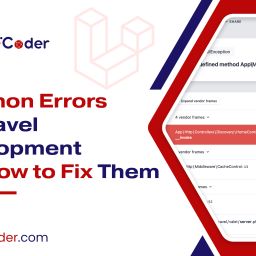
The success of a project is significantly influenced by the selection of the right technology stack in the ever-changing field of web development. Of the numerous alternatives, Laravel development and Node.js development stand out as popular selections, with each having unique advantages, disadvantages, and best practices. To help developers make wise decisions for their web development endeavors, this analysis will examine the features, benefits, and factors of both Laravel web development and Node.js web development.
The PHP framework Laravel development is well-liked for its sophisticated syntax, extensive feature set, and developer-friendly environment. It is particularly good at structured web development, providing tools for effective application development and upkeep. Conversely, Node.js takes advantage of JavaScript’s flexibility to give developers server-side execution capabilities; it’s especially well-suited for microservices and real-time applications.
Through learning the unique features of Laravel development and Node.js development, developers learn about their advantages and suitability for a range of project needs. Whether looking for the scalability of Node.js or the simplicity of Laravel, knowing these technologies helps make wise decisions that align with project goals and objectives in the dynamic field of web development.
Introducing Laravel Web Development: The PHP Framework for Structured Web Development
The PHP community has given Laravel a lot of praise because of its sophisticated syntax, robust features, and developer-friendly setting. Based on the ideas of efficiency and simplicity, Laravel provides a well-organized framework for creating cutting-edge web applications. Because of its Model-View-Controller (MVC) architecture, which encourages code organization and maintainability, developers can work together more easily on projects of any size.
Important Laravel Features
1. Eloquent ORM: Because it offers a user-friendly interface for interacting with databases, Laravel’s integrated ORM makes database administration easier. Developers have little trouble defining relationships between models and carrying out standard database operations.
2. Blade Templating Engine: Creating dynamic, reusable views is made easier with Blade, Laravel’s lightweight templating engine. Blade makes it easy to create complex user interfaces with features like control structures and template inheritance.
3. Middleware and Routing: Laravel’s expressive routing system enables programmers to create readable, clear routes for responding to HTTP requests. With the help of middleware, developers can incorporate unique logic into their applications by offering a versatile mechanism for filtering HTTP requests and responses.
Introducing Node.js Web Development: Harnessing JavaScript for Server-Side Development
Node.js transformed web development by making it possible to run JavaScript server-side. Node.js, which is driven by Google’s V8 JavaScript engine, provides an event-driven, non-blocking architecture that is ideal for developing microservices and real-time applications. Because of its large module ecosystem and lightweight design, it is a well-liked option for developers looking for performance and scalability.
Key Node.js Features
1. Asynchronous I/O: Node.js is very good at managing concurrent I/O operations without interfering with the way other tasks are being completed. This makes it perfect for applications like chat programs and streaming platforms that need to have a high throughput and low latency.
2. npm (Node Package Manager): A wide range of modules and packages for Node.js are accessible via npm. When developing and maintaining Node.js applications, developers can choose from a multitude of tools offered by npm, including HTTP servers, database connectors, and utility libraries.
3. Event-Driven Architecture: Node.js uses an event-driven model to manage input/output, enabling programmers to create asynchronous, non-blocking code. This makes it possible for applications with high concurrency to scale more effectively and to use system resources more efficiently.
An Evaluation of Laravel and Node.js in Comparison
It’s important to take into account a number of factors, such as project complexity, developer familiarity, and performance requirements, when choosing between Laravel development and Node.js development for your project.
Let us compare on the basis of Performance and Scalability
Node.js is well known for its performance and scalability, especially in applications that need to manage a lot of connections at once. Because of its non-blocking I/O model, which guarantees effective resource usage and low overhead, real-time applications and microservices benefit greatly from it.
For conventional online apps, however, Laravel provides good performance and scalability. Laravel is a dependable option for a variety of applications due to its structured web development process and strong caching mechanisms, even though it might not match the raw performance of Node.js in highly concurrent scenarios.
Developer Experience and Learning Curve
Developers can begin using Laravel with relative ease thanks to its clear syntax and extensive documentation. Developers can concentrate on creating features rather than writing boilerplate code because of its expressive syntax and built-in features, which streamline common development tasks.
Despite its strength, Node.js might require more experience from developers who are unfamiliar with server-side JavaScript or asynchronous programming. Nonetheless, developers can more easily discover solutions to typical problems and pick up best practices thanks to its extensive ecosystem of modules and vibrant community.
Based on Use and Project Requirements
The final decision between Laravel development and Node.js development is based on the particular needs of your project. Building traditional web applications with form handling, database management, and server-side rendering is where Laravel shines. With its built-in features and structured approach to web development, it’s a great option for projects where maintainability and code organization are top priorities.
Node.js, on the other hand, excels in applications that need to be scalable, real-time, and highly concurrent. Because of its non-blocking I/O model and event-driven architecture, it is an excellent choice for developing streaming platforms, APIs, and other applications that require high throughput and low latency.
Conclusion
Strong tools are provided by both Laravel web development and Node Js web development, each with advantages and disadvantages of their own. Think about things like project goals, developer experience, and performance requirements when choosing between the two. Building traditional web applications with well-structured code and extensive functionality is a great use case for Laravel development.
On the other hand, Node.js development works well in applications that need high concurrency, scalability, and real-time communication. You can make a smart decision that supports the aims and objectives of your project by evaluating the features, advantages, and application cases of each technology. Whichever technology you decide between, Laravel for its elegance and simplicity or Node.js for its scalability and performance. Both offer the resources you need to realize your web development goals.
















